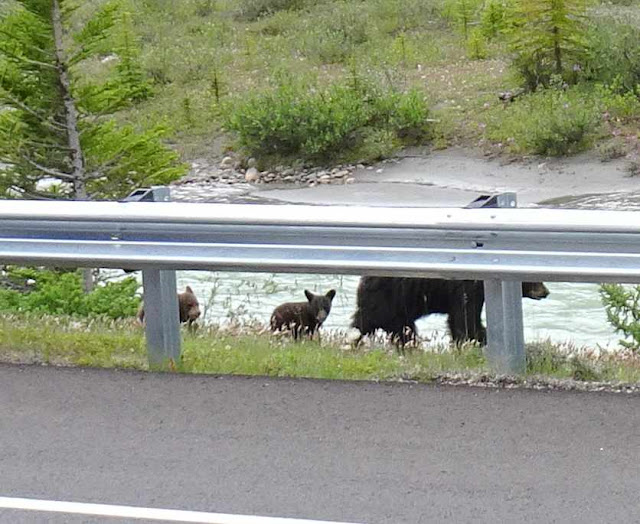While Mark is driving up and down the passes of the parkway, Denisa is sitting behind that big windshield snapping pictures of the passing mountains.
We are indeed wandering God's wonders today, as the mountains change shapes and colors on this drive.
The National Geographic has called this one of the ten best drives in the world, so we have been looking forward to it.
We weren't far into our drive before we had our first black bear sighting. He was just heading up the hill as we took this picture.
Note to self: Don't take pictures through the side window of the motor home unless you like glass reflections over your bear.
It takes three hours to drive from the village of Lake Louise to the town of Jasper. About in the middle, we changed from Banff National Park to Jasper National Park. The biggest climb comes immediately after a sweeping turn that took us almost 360 degrees before circling into more beautiful mountain views.
When we saw a traffic jam ahead, we figured it was because of a wildlife sighting. Sure enough, a mother black bear and her two cubs had brought traffic on the Icefield Parkway to a halt.
We didn't have a great view, as the bears were just on the other side of the guard rail. One cub was black, while the other was cinnamon. The little cinnamon bear gave us the best view when he darted on our side of the guard rail.
With no ranger in sight, it took a while to untangle the traffic jam and get everyone back on the road.
We couldn't help but notice that the closer we got to the end of our drive, the worse the pine trees were looking. The pine beetle blight has skipped Banff National Park for now, but has hit Jasper hard. When we saw mountain-sides of rust-colored pine trees, we tried to picture them as fall foliage instead of the dying pines that they are.
Our destination is Wabasso Campground, south of the town of Jasper. When we started making reservations for this trip last February, there were no camp sites with electricity available in Jasper National Park for the summer. Whistler Campground is the main place to camp, and its 700 sites were closed in 2019 for renovation. So when Mark found a 5-night cancellation at Wabasso, we grabbed that option and then planned the rest of our route around it. It was a little disconcerting to see a portable bear trap at the entry of our new campground.
But we're glad to have a camping space, and we're glad that Mark magically got our ailing electric transfer switch to work one more time as we plugged in to shore power. We are getting used to the 30-amp electrical sites with no water or sewer at these national park camp sites. We are good at knowing our electrical limitations, and we really appreciate the big tanks on our motor home that allow for comfortable stops even without hookups. We found this campground is less appealing because at least half the trees are dead. It also didn't help that our first visitor was this scary-looking bug on our windshield that was about the size of Denisa's hand.
We drove into the town of Jasper and saw that it has more to offer than our last two towns of Banff and Lake Louise. The national park information office gave us good information for our five day stay. We also got a picture with another set of red chairs beside a stuffed mountain goat.
The rangers in Canada have to also be actors, as we have seen two different entertaining plays at the national parks. Geared toward the children, adults will also enjoy learning about the plight of the little brown bats that live in Jasper National Park from these funny rangers.
We're also glad to see a larger grocery store in Jasper. The little convenience store-sized grocery in Lake Louise Village charged four times the normal price. After 11 days with no grocery shopping, we needed a few things. Still higher than usual, 4 liters of milk (just a little larger than a gallon) will cost $6.79 Canadian here in Jasper. When we factor in the exchange rate, that brings it down to $5.16 U.S.
We are surprised to see that most fruit is priced by the pound, because the price in kilograms is frightening.
Our shopping experience has a sweet ending. We had tried several new-to-us Canadian candy bars during the girls' trip. Denisa's sister took even more home to try, and she reported that the Eat-More bars were the family favorites. A four-pack is on sale, so we'll be eating more Eat-More as we start our exploration of Jasper National Park.


















No comments:
Post a Comment